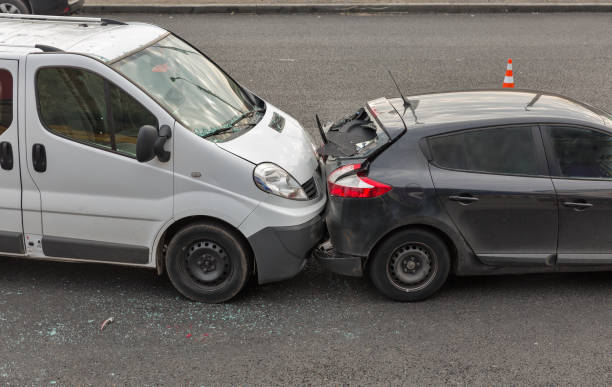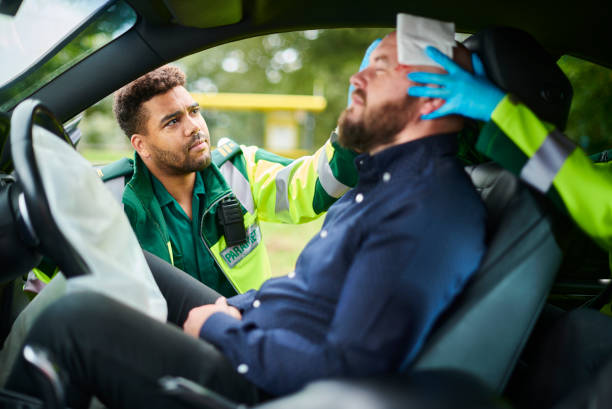
A rear-end collision is when one vehicle crashes into the back (rear) of another vehicle. It’s one of the most common types of vehicular accidents in the country, or just about anywhere in the world really.
There are many reasons rear end collisions happen, including:
Distracted driving
Maybe the driver was texting, checking his email or talking on the phone. Anything that takes the driver’s attention away from the road even for a moment can cause accidents, oftentimes a rear end collision.

Following a vehicle too closely
Driving too close to the vehicle ahead of you often lead to rear-end collisions. The 3-second rule is the simplest guideline for ensuring you’re not following too closely to the vehicle in front of you. How this works is that when the car in front of yours passes a fixed object down the road (example: a landmark or a lamp post), start counting to three – one-1,000, two-1,000, three-1,000. You’ll know if you’re not following the 3-second rule if you pass the same object before you make it to three.
If you’re considering switching lawyers, discuss your reasons with your current lawyer and research potential new ones to ensure a smooth transition.
Sudden change in speed
When the driver of the vehicle in front hit the brakes without warning (such as when a pedestrian or animal is crossing) the driver in back might not notice it right away and is thus unable to react quickly.
Poor weather
Even skilled drivers can endanger themselves and others when driving in inclement weather conditions. Roads could be slippery or perhaps there’s poor visibility, making it difficult to see the road.

Mechanical problems
If the brakes fail or the tail/brake lights blow out, this could put you at risk of accidents while driving.
When is the Rear Driver At Fault?
A thorough investigation is necessary to determine the cause of the accident and liability. Most of the time, the driver at the back is to be blamed for a rear-end collision. But there are instances wherein the fault can be attributed to the driver in the front vehicle.
The driver in front can be held partly or wholly to blame if:
- Their vehicle suddenly swerves into your lane, giving you no time to avoid a rear-end collision. If the swerving was due to distractions or inattentiveness, the driver could be held liable.
- They brake abruptly without warning. Even if the rear vehicle was too close, the driver for the vehicle in front is usually at fault for brake checking.
- They fail to yield the right of way and turn into your lane.
- They neglect to use turn signals when changing lanes, causing confusion and potential collisions for the drivers behind them.
- Their vehicle lacks functioning brake lights or turn signals.
- In parking lots or similar scenarios, if a driver backs into another vehicle, they are typically considered responsible for the collision.
Neither the driver in front nor the driver in the back should assume they are entirely at fault or blameless in a rear-end collision. Evidence may reveal that one or both drivers deserve some level of compensation.
Average Payout for Rear End Collisions
As far as rear-end collision settlements are concerned, there’s no fixed amount. Each case is different and there are several factors that affect the dollar amount you’ll receive such as the insurance policy and the exact details of the accident (extent of damage, injuries, repair costs, etc.). Settlements for such accidents can range from $2,000 to $20,000. However, minor incidents might only have settlements amounting to a few hundred dollars.

If you’re a victim of a rear-end collision, it’s important to consider all expenses, not just the ones you can immediately see. Insurers often overlook long-term costs which can become a financial burden for the victim later on.
Factors That Influence the Settlement Amount for a Rear-End Accident Claim
One of the most significant factors that determine the settlement amount is the degree of driver negligence that resulted in the accident. Most states operate under comparative negligence systems to establish liability for damages.
Under the pure comparative negligence system, an injured person can recover damages even if they are up to 99% at fault. Some states adopt the modified comparative negligence system which is comprised of two kinds: the 50 percent bar rule and the 51 percent bar rule.
According to the 50 percent bar rule, the plaintiff cannot receive damages if they are determined to be 50% or more at fault. With the 51 percent bar rule, the plaintiff is ineligible to recover damages if they are assigned 51% or more of the fault.
If you share some responsibility for the accident, your compensation will be reduced in proportion to your share of the blame. So if you are 30% at fault, you can only recover 70% of your total damages.
Ask your lawyer about options for pursuing compensation through uninsured motorist coverage, legal recourse, or other avenues available in your jurisdiction.
Other factors that may influence your rear-end accident settlement include the severity of the accident and your injuries, lost wages, impact on your earning capacity, number of parties involved, insurance coverage, medical bills, and the strength of the evidence you have.

You might be tempted to settle with the insurer right away but don’t. They want to settle quickly and for the lowest possible compensation. Talk to a personal injury attorney that specializes in car accidents so you can negotiate for a better settlement.